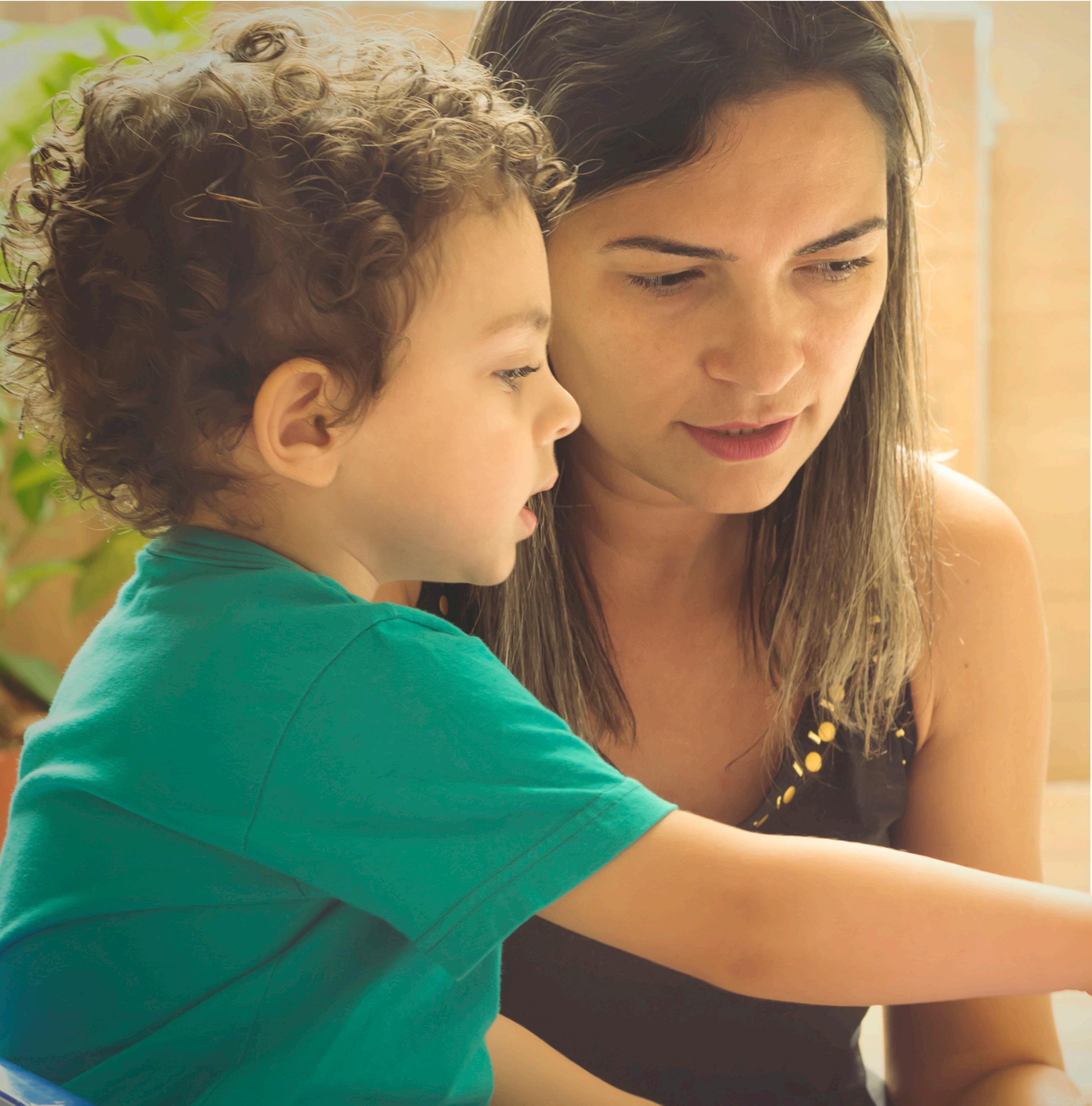How does a child learn learn kindness, empathy, and respect for others?
Every individual must learn what it means to be human. And we know that early childhood is when this learning begins. We also know that it isn’t what we say but what we do that matters most for children. They model our behavior. We know that strong adults make strong children, and this leads to thriving communities. Humanity is not a lofty idea; it’s the heart of our daily life. It’s how we treat one another. It’s everything we say and do, and it’s what children experience and learn from every day. Strengthening our humanity is fulfilling our true potential. It’s a necessity, not an option. And it’s not only for some of us, but for all of us. Humanity starts with you.
In this book, we offer a framework of 11 Simple Rules for communities to use for forging equitable partnerships for each other and for our children. Using these 11 Simple Rules will assist you in establishing a shared vision of quality relationships and interactions, environments, and learning experiences. We hope you will use it as the basis for inclusive conversations that build on the wisdom and experience within your community.
Many times we think that being an influence in the lives of children requires a playbook of major actions. It doesn’t. It requires effortless but purposeful interactions that allow for real transformation to take root. That is what the 11 Simple Rules give space to do. They open up the possibility of making real change in a way that is not complicated.
— Leigh Sargent, executive director, Tallahatchie Early Learning Alliance


Judy and Nichole invite readers to join them in a conversation about what it takes to build communities in which children flourish — then to continue the conversation with families and colleagues. They articulate best practices clearly and perhaps even more importantly convey that who and how we are matters in the work of helping children reach their full human potential. Aware of our different learning styles and preferences, the authors wisely offer a variety of entry points to the conversation including through research, a story, practical tips, and beautiful photos. No matter our role in children’s lives, each of us who reads this book is sure to feel affirmed and stretched — a winning combination for readers and the children we care for and teach.
— Amy Laura Dombro, consultant and writer
Humanity Starts with You
11 Simple Rules
Create Thriving Communities for Children

Judy Jablon is the founder and Executive Director at Leading for Children, providing strategic direction to execute LFC’s mission to realize shared power and a commitment to equity. She has enjoyed more than forty years in early learning as an educational consultant, facilitator, and author of books including Powerful Interactions: How to Connect with Children to Extend Their Learning and The Five Commitments of Optimistic Leaders: A Reflective Practice Journal.
Nichole Parks is the Director of Programs at Leading for Children, supporting the development and implementation of programs that promote transformational relationships. Nichole has developed place-based resources in several states and is a co-author of The Five Commitments of Optimistic Leaders: A Reflective Practice Journal
Leading for Children Publications
71 South Orange Avenue, #356
South Orange, NJ 07079
www.leadingforchildren.org
Judy Jablon and Nichole Parks
JABLON | PARKS 11
Rules to Create Thriving Communities for
to
Simple
Children
“ “ ” ”
Leading for Children
Humanity Starts with You
11 Simple Rules to Create Thriving Communities for Children
1
JUDY JABLON AND NICHOLE PARKS
Part 1
Part 3
Simple
Part 2
SIMPLE RULE #1: HONEST 29
31 Understanding Honest Relationships and Interactions
31 In the Workplace
32 In a Childcare Setting
33 Why Do Honest Relationships and Interactions Matter?
34 Take a Look: Honest Relationships and Interactions in Communities
SIMPLE RULE #2: OPEN 39
41 Understanding Open Relationships and Interactions
41 At Home
41 In a Childcare Setting
43 Why Do Open Relationships and Interactions Matter?
44 Take a Look: Open Relationships and Interactions in Communities
WELCOME
Humanity Starts with You 10 About the Book
7
Simple Rules for Relationships and Interactions: Honest,
and Two-Way
Simple Rules for the Emotional and Physical Environment: Safe, Calm, Organized, and Respectful 19 Simple Rules For Learning Experiences: Meaningful, Exploratory, and Actionable 22 The 11 Simple Rules Are Guideposts 23 The 11 Simple Rules Framework Promotes Greater Equity
The 11 Simple Rules Framework 13
Open, Trusting,
15
Rules for RELATIONSHIPS and INTERACTIONS
Contents
SIMPLE RULE #3: TRUSTING 49
50 Understanding Trusting Relationships and Interactions
50 In the Workplace
50 In a Childcare Setting
53 Why Do Trusting Relationships and Interactions Matter?
54 Take a Look: Trusting Relationships and Interactions in Communities
SIMPLE RULE #4: TWO-WAY 59
61 Understanding Two-Way Relationships and Interactions
61 At Home
61 In a Childcare Setting
62 Why Do Two-Way Relationships and Interactions Matter?
64 Take a Look: Two-Way Relationships and Interactions in Communities
68 Reflecting on Relationships and Interactions
68 Tips to Strengthen Relationships and Interactions
Part 4
Simple Rules for the EMOTIONAL AND PHYSICAL ENVIRONMENT
SIMPLE RULE #5: SAFE 73 45
75 Understanding a Safe Emotional and Physical Environment
75 At Home
75 In a Childcare Setting
76 Why Do Safe Emotional and Physical Environments Matter?
78 Take a Look: Safe Emotional and Physical Environments in Communities
SIMPLE RULE #6: CALM 83
85 Understanding Calm Emotional and Physical Environments
85 At Home
85 In a Childcare Setting
86 Why Do Calm Emotional and Physical Environments Matter?
88 Take a Look: Calm Emotional and Physical Environments in Communities
SIMPLE RULE #7: ORGANIZED 93
95 Understanding Organized Emotional and Physical Environments
95 At Home
95 In a Childcare Setting
97 Why Do Organized Emotional and Physical Environments Matter?
98 Take a Look: Organized Emotional and Physical Environments in Communities
SIMPLE RULE #8: RESPECTFUL 103 105 Understanding Respectful Emotional and Physical Environments 105 At Home 105 In a Childcare Setting 106 Why Do Respectful Emotional and Physical Environments Matter? 108 Take a Look: Respectful Emotional and Physical Environments in Communities 112 Reflecting on the Emotional and Physical Environment 112 Tips to Create Emotional and Physical Environments That Support Everyone
LEARNING EXPERIENCES SIMPLE RULE #9: MEANINGFUL 115 119 Understanding Meaningful Learning Experiences 119 In the Workplace 120 In a Childcare Setting 121 Why do Meaningful Learning Experiences Matter? 122 Take a Look: Meaningful Learning Experiences in Communities SIMPLE RULE #10: EXPLORATORY 127 129 Understanding Exploratory Learning Experiences 129 At Home 129 In a Childcare Setting 131 Why Do Exploratory Learning Experiences Matter? 132 Take a Look: Exploratory Learning Experiences in Communities SIMPLE RULE #11: ACTIONABLE 137 139 Understanding Actionable Learning Experiences 139 At Home 139 In a Childcare Setting 141 Why Do Actionable Learning Experiences Matter? 142 Take a Look: Actionable Learning Experiences in Communities 146 Reflecting on Learning Experiences 146 Tips for Creating Optimal Learning Experiences Part 6 Taking Action 148 149 How You Can Begin 150 References 158 Acknowledgments 160 About the Authors
Part 5 Simple Rules for

Welcome Humanity Starts with You
How does a child cultivate an understanding of humanity? How do they learn kindness, empathy, and respect for others? Every individual must learn what it means to be human. And we know that early childhood is when this learning begins. We also know that it isn’t what we say but what we do that matters most for children. They model our behavior.
Regardless of your role in a child’s life, you help them learn to trust, explore, develop, and learn. There are so many ways your unique qualities matter for children. Your smile, sense of humor, the special sound of your voice, and the interests you share with children all contribute to how they understand the world around them. Everything they see in you and all the experiences and interactions they have with you significantly contribute to who they become. How you choose to be when you are around children—both your actions and your words—serves as a model for how to be in the world. You consistently send messages that shape how children see themselves, others, and the process of learning.
To thrive is to flourish, it is to bloom. For a child, it means that they are able to meet their potential, to be happy, healthy, joyful, curious, and strong.
—Joan Lombardi
7 ˜
Part 1˜
As the adults in children’s lives, we have the ability and responsibility to ensure that children thrive. While this is a sacred trust, it’s not without challenges. It’s hard to consistently be the responsive, encouraging partner that children need. The daily care of young children, whether as a caregiver, parent, family member, or educator, can be tiring and sometimes overwhelming. In addition, systemic inequities, crises of conflict, climate change, and COVID-19 have greatly exacerbated some of the challenges the adults in children’s lives face each day. Many of us go to bed each night worrying and wondering.
Are you, like so many of us, struggling to find the resilience needed to be fully present and intentional with children as you constantly pivot and respond to changes around you? Whether it’s navigating a patchwork of care and support for your child so you can go to work; making decisions about virtual or in-person learning; or supporting the social emotional development of your child, we’re seeing that the resilience of families has been stretched in unprecedented ways across all demographics.
Are you, like so many educators of young children in settings everywhere, navigating your own family life and at the same time trying to show up effectively at work for children, families, and colleagues? Perhaps you’re struggling to make a living wage by holding two jobs and still effectively providing exemplary care and education. The field of early learning is rife with declining morale, anxiety, exhaustion, and depression. As educators, many of us are living in a state of stress.
Yet research and years of experience show that we have capacities we can harness and strengthen. We can empower ourselves to act with intention even in difficult circumstances. To realize this, we must work together. When we unite as partners to be our best for children, we can lighten each other’s burdens. We can no longer afford the status quo of hierarchies, siloed roles, and inequitable power structures that create tension and dissonance, nullifying efforts for true collaboration. We have to create systems that bring us together to strengthen one another and ensure that children thrive.
8
We know that strong adults make strong children, and this leads to thriving communities. Encouraging kindness, empathy, and respect for others are urgent tasks and are our only path toward a better future. Listening to each other is not extracurricular. It’s not just a nice thing to do. Humanity is not a lofty idea; it’s the heart of our daily life. It’s how we treat one another. It’s everything we say and do, and it’s what children experience and learn from every day. Building our humanity is fulfilling our true potential. It’s a necessity, not an option. And it’s not only for some of us, but for all of us. Humanity starts with you.

We invite you to harness your power and join us as leaders for children! We must come together and support each other to ensure that children can develop and learn in settings where they feel safe and secure. This requires all the important adults in children’s lives to share an understanding of what children need to thrive so that we can collectively apply it across all spaces where children live.
At the center of our coming together must be equity and respect for all. Children cannot thrive within systems that favor one child over another, nor can they thrive surrounded by socially constructed silos. For children to truly thrive, we must celebrate the humanity of each individual. This means changing the zero-sum thinking that what’s good for one group has to come at the expense of another. This is an imperative to achieving equity. Now is the time to tap into our wisdom and experience, and forge equitable partnerships for each other and for our children. We can create cultures of shared learning and decision making within our communities.
A critical first step to achieving equity is to start inclusive conversations among adults. In this book, 11 Simple Rules to Create Thriving Communities for Children, we offer a path to this shared understanding. During the past few years, we have seen
9
what occurs when communities of adults come together and engage in authentic dialogue about their vision for children. In Mississippi, our colleagues have used the 11 Simple Rules framework to strengthen relationships between families and childcare centers and foster collaboration among educators in childcare centers. In Wyoming, the 11 Simple Rules ignited conversations among adults with very different roles within the young child’s ecosystem, and the result is a new statewide vision of what children need to thrive that guided the development of Wyoming’s early-learning standards.
Imagine our communities as places where all relationships and interactions among adults and children are honest, open, trusting, and two-way. Where our environments— our homes, workplaces, parks, libraries, or early-learning programs—are safe, calm, organized, and respectful. Where adults and children together learn with and from each other in ways that are meaningful, exploratory, and actionable. How would that feel? How would it feel for you? How might it feel for children?
About the Book
We invite you to use the 11 Simple Rules to support you and your community in establishing a shared vision of quality relationships and interactions, environments, and learning experiences. We hope you will use it as the basis for inclusive conversations that build on the strengths, wisdom, and experience within your community.
This book is written for all the adults within the child’s ecosystem. Whether you are a family member, community leader, or kitchen manager in an early-learning

10
program, we hope this book provides inspiration and insight, and promotes a deeper understanding of your impact on the lives of children. While it can be used individually as a learning and self-reflection tool, we hope that you will use it to ignite collaborative conversations, learning, and growth.
The book is organized into six parts. You are reading Part 1, which we hope is welcoming you and providing a summary of our goals for this book. Part 2 is an overview of the 11 Simple Rules framework. Parts 3, 4, and 5 describe the rules in detail. We have organized the rules according to three categories—relationships and interactions, the emotional and physical environment, and learning experiences—because these are important aspects of what helps children to thrive. We offer an in-depth exploration of each simple rule using photos, examples, reflective questions, and research findings substantiating its importance. In Part 6, we invite you to take action, to be a change agent and a leader for children. We offer tools to support you in conversations with others in your community to implement the 11 Simple Rules. Finally, we have included a comprehensive list of references organized by the rules at the end of the book.
We believe this book will help us achieve equity in all our actions, interactions, and throughout our environments. As you read the 11 Simple Rules and talk about them with others, strive to share language, understanding, and intention about how to be with children and each other. And as you use the 11 Simple Rules day to day, cultivate self-awareness in order to be purposeful about your actions with and on behalf of children.
We have a fierce passion to make a difference in children’s lives. If you have chosen to pick up this book, we believe you share our passion. Let’s work together to put humanity first for our children.
Judy and Nichole
11
The 11 Simple Rules Framework
We initially conceived of the 11 Simple Rules as a way to ensure quality early learning for young children, creating a safe and nurturing environment while promoting their physical, social, emotional, and intellectual development. However, we quickly recognized two important ideas that have influenced the thinking in this book: 1) these simple rules apply to all spaces where children spend time, and 2) they also apply to adults and can create a healthier climate for everyone. When adults thrive, children have a better chance to thrive!
Accessible to all and replicable in any setting, the 11 Simple Rules are organized into three important categories that are easy to remember and uncomplicated to talk about.
Relationships and interactions that are honest, open, trusting, and two-way.
Emotional and physical environments that are safe, calm, organized, and respectful.
Learning experiences that are meaningful, exploratory, and actionable.
12
˜ Part 2˜
Simple Rules for Relationships and Interactions
Healthy relationships and interactions begin with you!
Four simple rules guide our decision making as we engage in strong, positive relationships and interactions: they are HONEST, OPEN, TRUSTING, and TWO-WAY. These four simple rules together lay the foundation for equity and respect in relationships and interactions.
27
˜ Part 3˜

Simple Rule # 1 Honest
Be honest in your relationships and interactions.
Honest means genuine, truthful, and not deceptive. When you choose to be honest in relationships and interactions, you let others get to know the real you—your authentic and sincere self. When you’re honest in relationships, you communicate a true desire to know another person and a willingness to let them know you. At the same time, being honest doesn’t mean telling everything about yourself. Sometimes we keep things to ourselves to preserve boundaries or to avoid causing hurt or embarrassment to another person.
0What words or phrases come to mind as you think about honest relationships and interactions?

Sincere, genuine, authentic, transparent
29
Ms. Marneshia and Ms. Gina sit side by side in honest conversation. Their willingness to be genuine and transparent with each other sets the tone for a positive program climate. What do you notice that conveys to you that Ms. Marneshia and Ms. Gina are having an honest interaction?

30 SIMPLE RULE #1 • HONEST
Understanding Honest Relationships and Interactions
How do we create honest relationships and interactions? We’re authentic and truthful. As you read these stories, notice what the simple rule of honesty looks like day to day.

IN THE WORKPLACE
Sarah and Maria are close friends who work at the community family resource center. Recently, Maria was promoted to site manager. As the site manager, she is now part of the leadership team responsible for making decisions and guiding the direction of the center. During a dinner together, Sarah asks Maria about a recent leadership meeting. Maria pauses as she navigates her feelings about Sarah’s questions. She wants things to be comfortable between the two of them, but she also knows it would be unprofessional to discuss leadership conversations. She hadn’t thought about how her promotion could change the dynamics of her friendship. Maria says, “Sarah, I know we usually tell each other everything and it feels weird not to be able to discuss certain things with you. It’s also important to me that I maintain professional integrity. I can’t discuss those conversations with you. Thank you for respecting that.” By being honest about how she was experiencing the conversation, Maria was able to convey healthy boundaries.
31
IN A CHILDCARE SETTING
Liana, a four-year-old with hearing loss, is new to Dominique’s classroom at Springdale Elementary School. On the first day of school, Liana’s parents, Mia and Liko, demonstrate how to manage Liana’s hearing aids and ask Dominique to wear an assistive amplification device. Dominique accepts the technology, and the parents say goodbye. Dominique is nervous. She’s never used this equipment before and while Liana’s parents have described to her how it works, she doesn’t feel comfortable. Dominique is committed to being honest, so at the end of the day, she asks Liana’s parents to show her how to use the technology again. The next morning, Mia and Liko arrive smiling. They express their gratitude to Dominique, saying, “Thank you so much for asking us! In the past, we’ve just dropped Liana off at school, crossed our fingers, and hoped she can hear what she needs to learn.” Going forward, Dominique and Liana’s parents have regular conversations at drop-off. As weeks pass, Mia and Liko notice that Liana is smiling when she gets home and speaking about her new friends. Dominique’s honesty about her discomfort and desire to learn more allowed her to gain the knowledge necessary to support Liana, while also building trust with Liana’s parents.
0 What did you find interesting as you read about honesty in action?
Think about a recent interaction you had that was honest. What made it so?
Choose one story to think about. How might things have turned out if the person didn’t choose to be honest?
32 SIMPLE RULE #1 • HONEST
Why Do Honest Relationships and Interactions Matter?
When relationships and interactions are honest, people are willing to be transparent and vulnerable in a respectful way. They send the message “I’m real with you and it’s safe for you to be real with me.” Humans need to feel a sense of belonging, to be valued and supported. Research shows that when we’re honest in our personal and professional lives, we’re more likely to have relationships that meet this fundamental need. Sometimes being honest means delivering news that is hard to hear. Being kind in what and how you choose to share is really important so that you preserve the relationship.
RESEARCH TELLS US
Honest relationships and interactions strengthen connections. When we’re honest, what we’re thinking and feeling internally matches how we act and behave with others. This conveys that we’re dependable. Others know what to expect from us. When expectations between people are clear, there is less anxiety about what we say and do. When people have honest
communication and authentic interpersonal interactions at home and at work they tend to be less stressed and more relaxed.
Honest relationships and interactions lead to more honesty. Honest relationships and interactions are contagious. Adults who are honest in their interactions with other adults are modeling honesty for children. When adults are honest with children, they also encourage children to behave with honesty. Honest interactions lead to stronger connections, and with each honest interaction, the effects ripple outward.
Honest relationships and interactions encourage collaboration and problem solving. When others are honest with us, we are more likely to adjust to change. We are more open to discussing and learning from our mistakes. When others around us are honest, it’s easier to work together to seek solutions. We approach challenges with a clear and shared understanding of how we can work together and learn from each other. We are less likely to find ourselves caught in power struggles. Honest relationships and interactions enhance our ability to face challenges and solve problems.
0As you consider the research about honest relationships and interactions, what feels important to you?
33
Honest Relationships and Interactions in Communities
We invite you to observe the honest relationships and interactions shared by our partners in communities near and far.
A small group of children have gathered outdoors for a serious, honest conversation. They have been reading a book about race and belonging, and the children are eager to share their feelings.

34 SIMPLE RULE #1 • HONEST TAKE A LOOK
Observe the genuine emotions of this teacher-child interaction. When children can express their true and honest feelings with their teachers, they learn to trust and are more open to learning.

35
It’s a moment of big-sister honesty as Adelaide tells her little brother, Solomon, how much she loves playing with him.

36 SIMPLE RULE #1 • HONEST
Invitation to Explore
Think of someone you know who makes it easy for you to be honest and authentic. What qualities do they possess that help you feel that way? Do you share any of them?
Think about a connection you have that you would like to strengthen. When might you see them next? Could you arrange a chat? Set an intention to pause and think about how you want to check in.
37 0

About the Authors
Judy Jablon is the founder and Executive Director of Leading for Children, a national non-profit organization. After having spent over forty years in the field of early learning, Judy has developed a groundbreaking model that focuses on community and the collective wisdom of its members. Her work centers around the great passion and determination of all the different individuals who dedicate their lives to leading for children. Judy is the author of numerous books and resources for the field including Powerful Interactions: How to Connect with Children to Extend Their Learning, and The Five Commitments of Optimistic Leaders: A Reflective Practice Journal. Judy began Leading for Children in 2016 to focus on equity in early learning by ensuring that all the adults in the young child’s ecosystem can come together to collectively solve the challenges of their communities by using their wisdom and experience. LFC’s projects are currently under way in more than ten states across the country.

Nichole Parks is the Director of Programs at Leading for Children. Her philosophy is that by nurturing the growth and development of the adults in the child’s ecosystem, we create pathways to sustainable quality and take steps to create a more equitable world for our children. During her twenty-nine years in early childhood education, she’s taught preschool and served children and families as the Infant and Toddler Director of NAEYC accredited program. Prior to joining LFC she was the Quality Rating Improvement System Coordinator with Arkansas State University Childhood Services, where she coordinated trainings, coaching, assessments, and initiatives for early childhood program administrators. Nichole has developed placebased resources in several states and is a co-author of The Five Commitments of Optimistic Leaders: A Reflective Practice Journal.

160

















